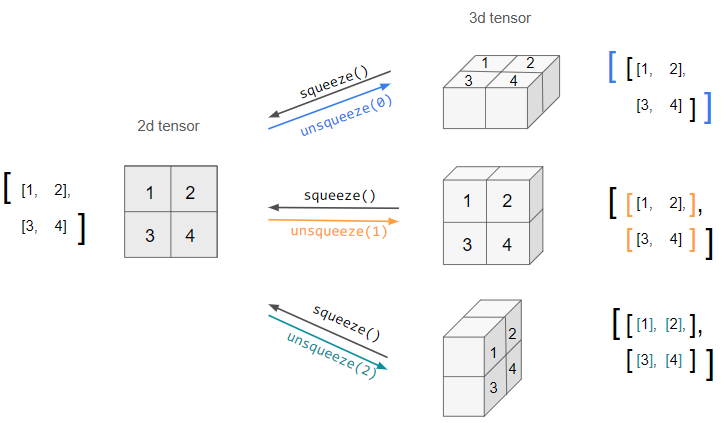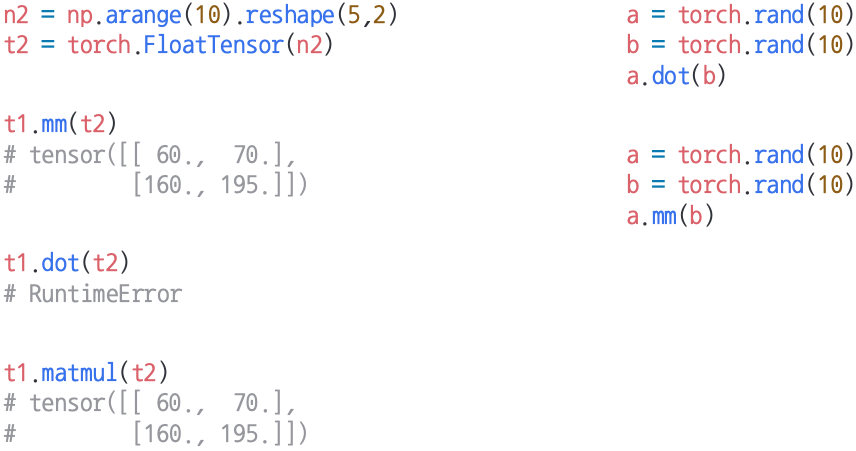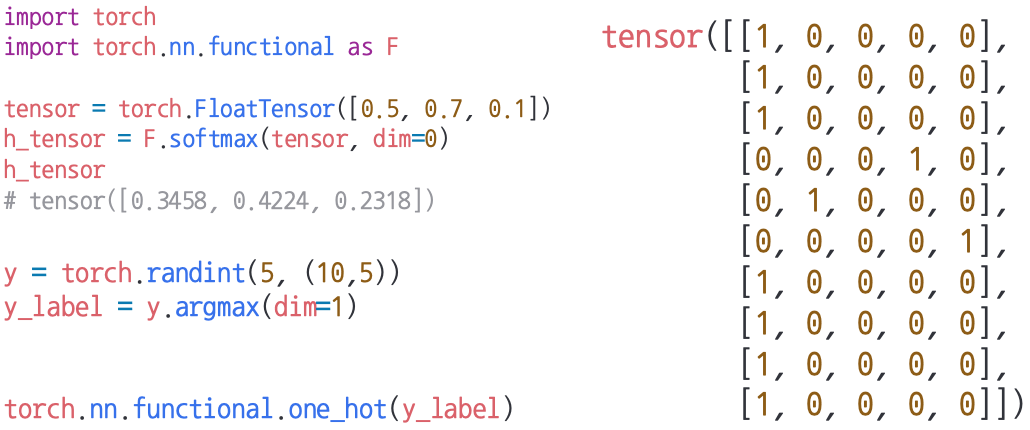
✏️Introduction to PyTorch
.vs TensorFlow
- TensorFlow
- Static graphs (Define and Run)
- 그래프를 먼저 정의 → 실행시점에 data feed
- Production, Cloud, Multi-GPU 등 scalability에 강점을 가짐
- PyTorch
- Dynamic computation graphs (Define by Run)
- 실행을 하면서 그래프를 생성하는 방식
- 즉시 확인 및 디버깅 가능 (pythonic code)
- 사용하기 편한 장점
- GPU support, Good API and community
Numpy + AutoGrad + Function
- Numpy 구조를 가지는 Tensor 객체로 array 표현
- 자동미분을 지원하여 DL 연산을 지원
- 다양한 형태의 DL을 지원하는 함수와 모델을 지원함
✏️PyTorch Basics
Tensor
- 다차원 arrays를 표현하는 PyTorch 클래스
- nump의 ndarray와 유사 (tensorflow의 tensor와도 유사)
# numpy - ndarray
import numpy as np
n_array = np.arrange(10).reshape(2,5)
print(n_array)
print("ndim: ", n_array.ndim, "shape: ", n_array.shape)
# pytorch - tensor
import torch
t_array = torch.FloatTensor(n_array)
print(t_array)
print("ndim: ", t_array.ndim, "shape: ", t_array.shape)- pytorch의 tensor는 GPU에 올려서 사용가능
import torch
data = [[3, 5, 10], [2, 3, 6]]
x_data = torch.tensor(data)
x_data.device
# device(type='cpu')
if torch.cuda.is_available():
x_data_cuda = x_data.to('cuda')
x_data_cuda.device
# device(type='cuda', index=0)Tensor Handling
import torch
tensor_ex = torch.rand(size=(2,3,2)) # torch.size([2,3,2])
tensor_ex.view([-1, 6]) # torch.size([2,6])
tensor_ex.reshape([-1, 6]) # torch.size([2,6])-
view와 reshape의 차이 : contiguous
-> https://inmoonlight.github.io/2021/03/03/PyTorch-view-transpose-reshape/
-> view 사용 추천 (메모리 관리 차원) -
squeeze and unsqueeze

Tensor Operations
- 행렬곱셈 연산은 함수 dot이 아닌 mm 사용
-> dot : 벡터(1D tensor) 내적용, mm, matmul : 행렬(2D tensor) 곱셈용

- 나머지 연산은 numpy와 동일
- mm과 matmul의 차이: broadcasting 지원 유무
-> mm : 미지원, matmul : 지원
-> 결과가 헷갈릴 수 있으니 mm 사용 추천

-> (5(=batch),2,3) → (2, 3) · (3, 1)[broadcasting] = (5,2,1)
Tensor operations for ML/DL formula
- nn.functional 모듈을 통해 다양한 수식 변환을 지원

AutoGrad
- PyTorch의 핵심은 자동 미분의 지원 → backward 함수 사용
- 미분 시킬 target은 'requires_grad=True' 파라미터 설정 필요
import torch
w = torch.tensor(2.0, requires_grad=True)
y = w**2
z = 10 * y + 25
z.backward()
w.grad # tensor(40.)
a = torch.tensor([2., 3.], requires_grad=True)
b = torch.tensor([6., 4.], requires_grad=True)
Q = 3*a**3 - b**2
external_grad = torch.tensor([1., 1.])
Q.backward(gradient = external_grad)
a.grad # tensor([36., 81.])
b.grad # tensor([-12., -8.])- reference:
🔗Image Reference
✏️PyTorch project
Project Template
- 초기 단계에서는 대화식 개발 과정이 유리 → 개발하고 확인하고, 개발하고 확인하고...
-> 학습과정과 디버깅 등 지속적인 확인 - 배포 및 공유 단계에서는 jupyter notebook 공유의 어려움
-> 쉬운 재현의 어려움, 실행순서 꼬임 - 다양한 프로젝트 템풀릿이 존재 → 필요에 따라 수정하여 사용
- 실행, 데이터, 모델, 설정, 로깅, 지표, 유틸리티 등 다양한 모듈들을 분리하여 프로젝트 템플릿화

📕특강 - 라이엇 게임즈 유석문 CTO님
프로그래머로 산다는 것
- 코딩을 재밌어하는 사람이 프로그래머가 되어야 한다.
-> 단순히 밥벌이로? 그럼 하지 마. - 코드를 이해해라. 단순히 copy & paste로는 개발 능력이 늘 수 없다.
- 개발자는 항상 새로운 기술을 공부하고 적용할 준비가 되어 있어야 한다.
개발자의 필수능력
- 깔끔한 코드
- 사람이 이해하기 쉬운 코드 (readability)
- 변경 용이한 코드
- 유지보수 비용이 낮은 코드
- 사용하는 코드만 만들기 (Caller Create)
- 리팩토링 (Refactoring)
- 코드 읽기 (Code Review
- ATDD : client 입장에서 테스트
- TDD : developer 입장에서 테스트 (unit test)
- 적절한 논리력
- 원리 탐색 능력
- 제약조건을 고려한 해법
- 단순한 디자인
- 알고리즘과 자료구조 중요
- 엔지니어(engineer)란? : 가용 가능한 리소스를 갖고 가장 적절한 해법을 찾아 문제를 해결하는 자
(닭 잡는데 소 잡는 칼 쓸 필요 없다)
능력을 어떻게 키울까?
- 꾸준한 연습 (Daily Practice)
- 매일 몸값 올리는 시간을 가져라
- 멀리 가고 싶다면 함께 가라
- 현재 필요한 만큼만 해라
- 간단하게 해라
좋은 개발자
- 협업 (상대를 이해하자)
-> 자아존중감 높은 사람이 되자 : 타인의 부정적 견해에 크게 영향 받지 말라 - 공유 (주변이 똑똑해져야 내가 편함)
-> 내가 속한 무리의 가장 똑똑한 사람이라면 그 무리를 떠나라. - domain knowledge가 다양
